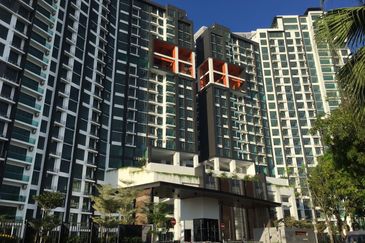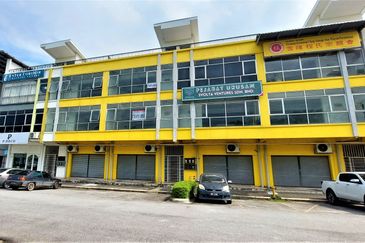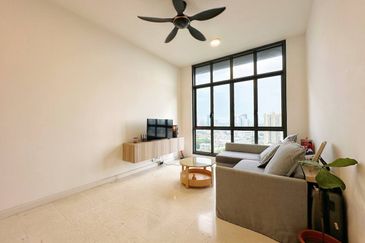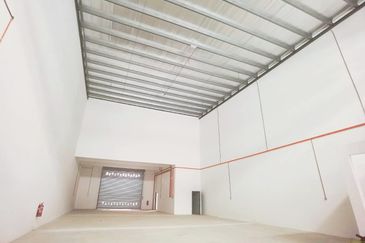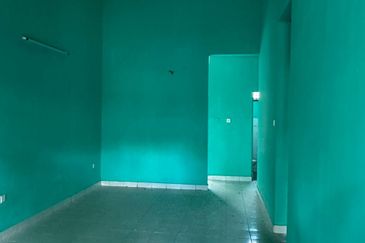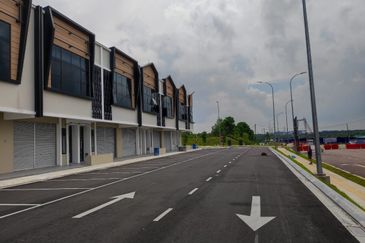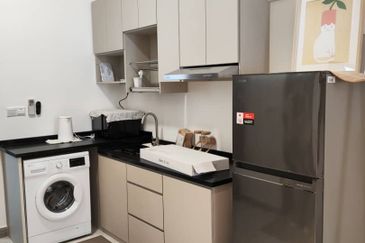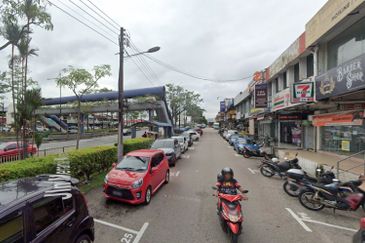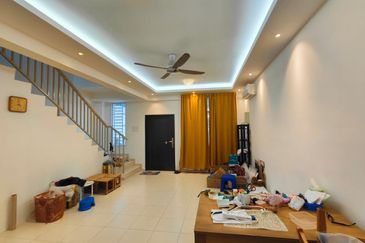Upon entering the snazzy showflat of The Hillier, a trendy SOHO-style condominium by giant property developer Far East Organization (FEO), it’s clear why the project has sold 309 units out of 411 released since it previewed on Dec 16, just eight days after the harshest measures meted out by the government in the form of additional buyer’s stamp duty (ABSD) of 3% for Singaporeans buying their third property and Permanent Residents buying their second; and 10% for all residential purchases by foreigners. Average prices, which were at S$1,174 psf when previews were first held, have since crept up to S$1,200 psf.
 The Hillier is a 528-unit SOHO residential project, with two residential towers sitting on top of a retail podium called HillV2. The project is located at Hillview Avenue. The developer has also secured tenants for its HillV2 mall, including New York-based upscale retailer of gourmet and speciality food Dean & Deluca and ice-cream parlour chain Cold Stone Creamery, with the latest tenant being Cold Storage’s The Market Place as anchor tenant. The project is scheduled to be completed in 2016.
The Hillier is a 528-unit SOHO residential project, with two residential towers sitting on top of a retail podium called HillV2. The project is located at Hillview Avenue. The developer has also secured tenants for its HillV2 mall, including New York-based upscale retailer of gourmet and speciality food Dean & Deluca and ice-cream parlour chain Cold Stone Creamery, with the latest tenant being Cold Storage’s The Market Place as anchor tenant. The project is scheduled to be completed in 2016.
Within days of the new government measures, FEO swiftly came up with sweeteners to brighten the mood of homebuyers to lure them back to the market. At the preview of The Hillier, it offered stamp duty reimbursement, which works out to about 3% once the buyer has paid the stamp duty at the 20% down payment stage. It also offered a furniture voucher, the amount of which varies according to unit type and will only be given when the project obtains Temporary Occupation Permit (TOP).
“The showflat is very nicely done up; it’s one of the nicest I’ve seen. I think The Hillier did well partly because of the SOHO concept, and partly because of the discount structure and rebates offered by the developer, which are attractive from the buyer’s perspective,” says a property agent who declined to be named.
Why has FEO been able to offer such rebates and stamp duty reimbursements? The developer had a record year in 2011 in terms of new home sales. As at Dec 20, FEO sold more than 2,725 residential units worth S$3.5 billion. If sales of joint-venture projects were included, the number of units sold would be 3,794 units, for a total of S$4.5 billion. The figures are almost double the amount registered in 2009, when FEO sold 1,932 new homes valued at more than S$2.34 billion, including units sold in joint-venture projects.
New home sales were strong last year, ringing in at 16,000, which is almost on a par with the record 16,292 units sold in 2010. Demand last year was largely driven by mass-market condos. Private property prices have risen for nine straight quarters, and based on the 4Q flash estimates, the private property index has recovered 55% from the trough in 2Q2009. Last year, prices were up by 5.9% compared with 17.8% in 2010.
“Developers have seen strong sales and have done very well in the last few years,” says Donald Han, vice-chairman of Cushman & Wakefield Singapore. “They still have strong balance sheets and so they can afford to hold on to prices. They will only adjust prices downwards as a last resort.”
More developers offering sweeteners
Well aware that buying sentiment has been dampened by the recent government measures, some developers have taken the cue from FEO and started offering incentives to buyers. “Developers are now offering all kinds of sweeteners, including early bird discounts, some form of stamp duty absorption or reimbursement, furniture vouchers, interior design rebates and even legal fees absorption,” says Han.
 In the week before Christmas, around the time FEO previewed The Hillier, MCC Land, the property arm of China Metallurgical Group Corp, released 200 units in its 435-unit The Nautical private condo on Jalan Sedudok off Sembawang Road. After a 5% early bird discount, the average price of units at The Nautical worked out to S$860 psf. As at Jan 11, about 130 units were sold. “There may not have been 700 people coming over a weekend, but the preview attracted the right kind of crowd,” says Joseph Tan, executive director of residential at CB Richard Ellis (CBRE), the marketing agent for the project.
In the week before Christmas, around the time FEO previewed The Hillier, MCC Land, the property arm of China Metallurgical Group Corp, released 200 units in its 435-unit The Nautical private condo on Jalan Sedudok off Sembawang Road. After a 5% early bird discount, the average price of units at The Nautical worked out to S$860 psf. As at Jan 11, about 130 units were sold. “There may not have been 700 people coming over a weekend, but the preview attracted the right kind of crowd,” says Joseph Tan, executive director of residential at CB Richard Ellis (CBRE), the marketing agent for the project.
Another project that is about to start VIP preview is the 689-unit Parc Rosewood on Rosewood Drive, off Woodlands Avenue 1. According to marketing agents, the developer of the project, which is a joint venture between Fragrance Group and World Class Land, is said to be considering offering buyers an 18% discount, comprising a 10% discount, another 3% early bird discount, 3% stamp duty discount and a 2% furniture voucher payable upon TOP. After the 18% discount, prices of one-bedroom apartments will start from S$398,000 while two-bedroom units will be priced from S$568,000. The project is expected to preview on Jan 28.
So far, the incentives dangled by developers have drawn crowds, although buying has certainly become more selective. Over the weekend of Jan 7 and 8, the 590-unit Riversound Residence at Sengkang East Avenue, developed by Qingjian Realty, was launched. The average price for the whole development was said to be about S$850 psf after an 18% discount. The discount comprised a 12% basic discount, a 3% early bird discount and 3% stamp duty absorption, according to a Jan 9 UBS report by analysts Michael Lim and Adrian Chua, who visited the showflat.
The turnout at Riversound Residence was strong that first weekend, with about 700 people signing in at the showflat over the two days. However, buyers stayed on the sidelines, with converted sales at about 20% of the 250 units launched, according to the UBS analysts.
However, Emily Eng, director of residential division at SLP International, the marketing agent for Riversound Residence, says, “There was genuine interest, as buyers sat down for hours with agents and bankers to work out their finances.”
The majority of the buyers are said to be locals, with one foreign buyer, believed to be from mainland China, who bought a unit. One of the Singaporean buyers at Riversound Residence that weekend was Mr Cheng, a 31-year-old IT consultant and father of two young daughters. Cheng bought two adjacent units in the project — a 1,690 sq ft four-bedroom unit for himself and his family and a three-bedroom unit for his parents. The final price paid by Cheng after the various discounts amounted to S$1.1 million for the four-bedroom unit and S$980,000 for the three-bedroom apartment. “The price discount was attractive, otherwise I wouldn’t have bought,” admits Cheng.
For much of last year, he had been looking at new launches of 99-year leasehold condos in the Punggol and Sengkang areas such as A Treasure Trove by Sim Lian Group, where 785 of a total of 882 units had been sold at a median price at S$922 psf as at end-November. In Sengkang West Avenue, City Developments Ltd (CDL)’s 521-unit H2O Residences saw 450 units sold at a median price of S$936 psf as at end-October. And at Sengkang Square, Keppel Land had sold 242 of 300 units launched at its 622-unit The Luxurie at a median price of S$1,057 psf.
Cheng currently lives in a five-room HDB flat in Punggol that he purchased five years ago. He intends to sell it when he moves into his new apartment at Riversound Residence, which is scheduled for completion in 2015. “Agents tell me five-room resale flats in Punggol can fetch S$480,000 to S$500,000, we shall see,” he says.
‘Strike while the iron is hot’
Developers are wasting no time in rolling out their mass-market projects at the start of the year. Based on a compilation of launch-ready sites for 2012, DMG analysts estimate that 58% of the projects are in the mass-market segment.
“This is a window of opportunity for developers to strike while the iron is hot, and projects that are competitively priced will leapfrog the rest in terms of sales,” says Cushman & Wakefield’s Han. “The new launches of executive condos [ECs] and mass-market condos are doing fairly well because of the ‘wealth effect’ from the HDB market, fuelled by genuine first-time homebuyers and upgraders.”
This can certainly be seen at the launch of The Rainforest on Choa Chu Kang Avenue 3, the first EC to be launched this year. The 466-unit project is developed by CDL and TID Pte Ltd (a joint venture between Hong Leong Group and Mitsui Fudosan). On the first day it opened for bookings on Jan 11, the project saw 150 units sold at an average price of about S$730 psf.
Absolute prices of units ranged from S$601,000 for a two-bedroom-plus-study unit to S$689,000 for a three-bedroom unit. Four-bedroom units start from S$897,000, while penthouses are priced from S$1.01 million. The EC is located just a five-minute walk from Choa Chu Kang MRT station and Lot One Shoppers’ Mall, according to a CDL spokesman.
“Buyers are likely to be more selective on the back of more cautious economic sentiment and the impact of the additional property measures implemented by the government recently,” says a CDL spokesman. “Volume of sales will not be as swift as before and prices are likely to hover around current levels in the foreseeable future.”
Many homebuyers such as Peter, a 36-year-old Singaporean banker, are still sitting on the fence. Peter and his wife had purchased a unit at The Metropolitan on Alexandra Road in a sub-sale when the project was newly completed in 2009. At that time, the price was around S$1,040 psf. He sold his apartment last year for about S$1,300 psf and is on the hunt again. He had considered buying a four-bedroom unit at The Minton on Lorong Ah Soo, a 1,145-unit 99-year leasehold condo by developer Kheng Leong that was launched in the middle of 2010. “I liked the condo, but I changed my mind because there are so many new launches coming up,” he says.
Recently, he zoomed in on the Newton area, as it is in prime District 11 and more affordable than prices in District 9. He and his wife are keen on a 1,238 sq ft unit in an old apartment block on Surrey Road, just off Newton Road. “It’s nicely renovated and has a practical and spacious layout,” says Peter. The owner, however, is asking for S$1.58 million, or S$1,276 psf. “I told the property agent I’m not willing to offer anything more than S$1.4 million,” he says. “Older apartments are worth looking at because the units are more spacious.”
He’s holding back for now as he feels prices are still relatively high at the moment. “Prices need to come down by 10% to 15% before they become attractive enough for buyers like me,” he says.
However, Cushman & Wakefield’s Han says, “If you are expecting a 20% to 30% drop in prices this year, that’s not going to happen. There’s still a lot of cash in the system waiting for an opportunity to invest. Interest rates are still low and banks are still willing to lend. I would advise people to buy on dips. If prices were to drop 10%, it’s a good time to come in.” He forecasts a 10% to 12% drop in 2011, and another 10% drop in 2013.
How low will prices go?
The expectation is that the high-end segment will be impacted more severely from the reduction in foreign participation as a result of the ABSD. The mass market is likely to be affected by affordability concerns and HDB policies, notes Bank of America Merrill Lynch in a Jan 9 report. The analysts have adjusted their pricing forecasts to a 12.5% drop in 2012 and an 8% decline in 2013, hence a 20% decline in 2012/13, which is in line with previous down cycles.
During the Asian financial crisis in 1997/98, property prices dropped 55% from the peak, while in the recent global financial crisis, prices fell about 25% from the peak in 1Q2008, says Han. “People said the global financial crisis was going to be much worse, and many were waiting for prices to come off by 50%, but that didn’t happen,” he recalls. “This year is going to be a tale of two halves — a lacklustre first half, with things looking up in the second half.”
What could surprise the market, according to Nomura Research in its Jan 6 report, is if there is a speedy recovery of developer sales volume to pre-measures levels. “Based on the experience of the previous four rounds of cooling measures since September 2009, the recovery period appears to be two to six months (and shortening) with each new set of cooling measures announced,” writes Sai Min Chow, property analyst at Nomura. “However, if that were to happen, it would mean running the risk of a sixth round of government measures to prevent the market from overheating, reckons Nomura.
According to a Ministry of National Development spokeswoman, the ABSD is a calibrated measure to moderate investment demand by locals and foreigners in order to avoid the need for a sharper correction down the road. “As the ABSD has just been implemented, we are still closely monitoring its impact,” she says in an email response. “All measures are reviewed from time to time to ensure that they remain appropriate to the situation and achieve what they were designed to do.”
Developers are bracing themselves for slower sales as the impact of the new measures kicks in and new supply enters the market this year. Assuming that demand for new private homes falls by about 20% y-o-y in 2012, this will result in about 41,000 unsold private housing units in the pipeline, estimates property analysts at DMG & Partners in a Jan 11 report. The figure translates into a three-year supply of primary home sales (or developer sales). This could dampen private residential prices, say the analysts. “We believe developers would continue to monitor the market and hold back launches over time should there be lukewarm response to new launches in the near term,” the analysts say in their report.
Cecilia Chow is the editor of City & Country at The Edge Singapore
This article appeared in City & Country, the property pullout of The Edge Malaysia, Issue 895, Jan 30-Feb 5, 2012
TOP PICKS BY EDGEPROP
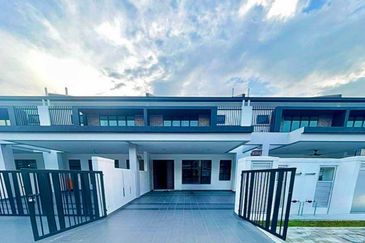
RIMBUN KIARA @ SEREMBAN 2
Seremban, Negeri Sembilan
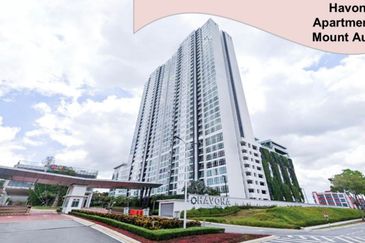
Havona Residence @ Taman Mount Austin
Johor Bahru, Johor

Havona Residence @ Taman Mount Austin
Johor Bahru, Johor
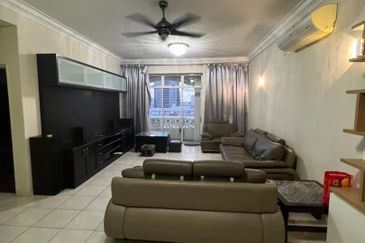
Pangsapuri Orchid View Luxury Apartment
Johor Bahru, Johor


